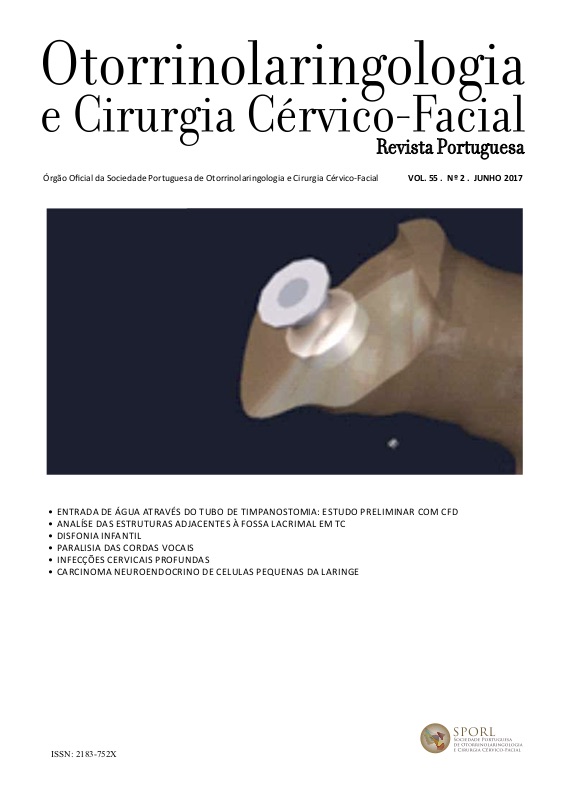Morphometric analysis of the anatomic structures adjacent to fossa lacrimal in computed tomography: Study of 100 patients
DOI:
https://doi.org/10.34631/sporl.630Keywords:
Endoscopic dacryocystorhinostomy, Lacrimal Fossa, Computed TomographyAbstract
Objectives: morphometric description of anatomical structures adjacent to the lacrimal fossa and discussion of their surgical applicability.
Study Design: Cross-sectional and retrospective.
Methods: Computed tomography of paranasal sinuses in 100 patients.
Results: Regarding the lacrimal fossa, the anterior limit of the middle turbinate head was anterior, adjacent and posterior in 45.5%, 10% and 44.5% of cases, respectively. The thickness of the ascending branch of the jaw in the area of the osteotomy was 5.2 mm. The lateral insertion of the process uncinate was pos lacrimal, lacrimal and pre lacrimal 52%, 33% and 15% of cases, respectively. The nasolacrimal duct and the lacrimal fossa measured 12.8 and 11 mm, respectively. The distance between naso lacrimal canal and the bone insertion of the middle turbinate was 4.8 mm. Approximately 60% of the lacrimal fossa is located above the middle turbinate insertion. The distance between the lacrimal fossa and the Agger Nasi was 6 mm.
Conclusions: The values obtained are similar to those found in the literature. At least half of endoscopic dacryocystorhinostomy procedures (DCR En) require additional procedures. CT SPN is essential in the study of patients with indication for DCR En.
Downloads
References
Watkins L, Janfaza P, Rubin P. The Evolution of Endonasal Dacryocystorhinostomy. Survey of Ophthalmology. Jan 2003 (48).
Leong SC, Macewen CJ, White PS. A systematic review of outcomes after dacryocystorhinostomy in adults. Am J Rhinol Allergy. 2010 Jan-Feb;24(1):81-90.
Tsirbas A, Davis G, Wormald PJ. Mechanical endonasal dacryocystorhinostomy versus external dacryocystorhinostomy. Ophthal Plast Reconstr Surg. 2004 Jan; 20(1):50-56.
Wormald P, Tsirbas A. Powered endoscopic dacryocystorhinostomy with mucosal flaps. Operative Techniques in Otolaryngology-Head and Neck Surgery. 2009; 20(2):92-95.
Fayet B, Racy E, Assouline M, Zerbib . Surgical anatomy of the lacrimal fossa a prospective computed tomodensitometry scan analysis. Ophthalmology. 2005 Jun; 112(6):11 19-28.
McDonogh M, Meiring JH: Endoscopic transnasal dacryocystorhinostomy. J Laryngol Otol. 1989. 103:585-7.
Wormald PJ, Kew J, Van Hasselt A. Intranasal anatomy of the nasolacrimal sac in endoscopic dacryocystorhinostomy. Otolaryngol Head Neck Surg. 2000 Sep;123(3):307-10.
Fayet B, Racy E, Assouline M. Complications of standardized endonasal dacryocystorhinostomy with unciformectomy. Ophthalmology.2004 Apr;111(4):837-45.
Marques M, Simão A, Santos A, et al. Análise da anatomia do recesso frontal em tomografia computorizada: Estudo de 50 doentes. Rev Port Oto cir cervico-Facial. 2001; (49) 1: 5-10.
Liang J, Hur K, Merbs SL, Lane AP. Surgical and Anatomic Considerations in Endoscopic Revision of Failed External Dacryocystorhinostomy. Otolar Head Neck Surg.2014 Mar (4).
Figueira E, Al Abbadi Z, Malhotra R, et al. Frequency of simultaneous nasal procedures in endoscopic dacryocystorhinostomy. Ophthal Plast Reconstr Surg. 2014 Jan-Feb;30(1):40-3.
Fayet B, Katowitz WR, E Racy, et al. Endoscopic dacryocystorhinostomy: the keys to surgical success. Ophthal Plast Reconstr Surg. 2014 Jan-Feb;30(1):69-71.
Basmak H, Cakli H, Sahin A, et al. What is the role of partial middle turbinectomy in endocanalicular laser-assisted endonasal dacryocystorhinostomy? Am J Rhinol Allergy.2011 Jul-Aug;25(4):e160-5.
Tsirbas A, Wormald P. Mechanical endonasal dacryocystorhinostomy with mucosal flaps. Br J Ophthalmol. Jan 2003; 87(1): 43–47.
Soyka MB, Treumann T, Schlegel. The Agger Nasi cell and uncinate process, the keys to proper access to the nasolacrimal drainage system. Rhinology. 2010 Sep;48(3):364-7.
Yang JW1, Oh HN. Success rate and complications of endonasal dacryocystorhinostomy with unciformectomy. Graefes Arch Clin Exp Ophthalmol. 2012 Oct;250(10):1509-13.
IPEK, E, ESIN, K, AMAC, K, et al. Morphological and morphometric evaluation of lacrimal groove. Anatomical Science International. 2007; 82 (4): 207-210.
Rebeiz E, Shapshay S, Bowlds J, et al. Anatomic guidelines for dacryocystorhinostomy. Laryngoscope 1992,102:1181-4.
McDonogh M, Meiring JH. Endoscopic transnasal dacryocystorhinostomy. J Laryngol Otol. 1989 Jun;103(6):585-7.
Sprekelsen MB, Barberán MT. Endoscopic dacryocystorhinostomy: surgical technique and results. Laryngoscope. 1996 Feb;106(2 Pt 1):187-9.
Zhang L, Han D, Ge W, Xian J, et al. Anatomical and computed tomographic analysis of the interaction between the uncinate process and the agger nasi cell.. Acta Otolaryngol. 2006 Aug;126(8):845-52.
Liang J, Hur K, Merbs SL, Lane AP. Surgical and Anatomic Considerations in Endoscopic Revision of Failed External Dacryocystorhinostomy. Otolaryngol Head Neck Surg.2014 Mar (no prelo/in press).
Blaylock WK, Moore CA, Linberg JV. Anterior ethmoid anatomy facilitates dacryocystorhinostomy. Arch Ophthalmol 1990;108:1774-7.
Talks SJ, Hopkisson B. The frequency of entry into an ethmoidal sinus when performing a dacryocystorhinostomy. Eye 1996; 10,742-743.






